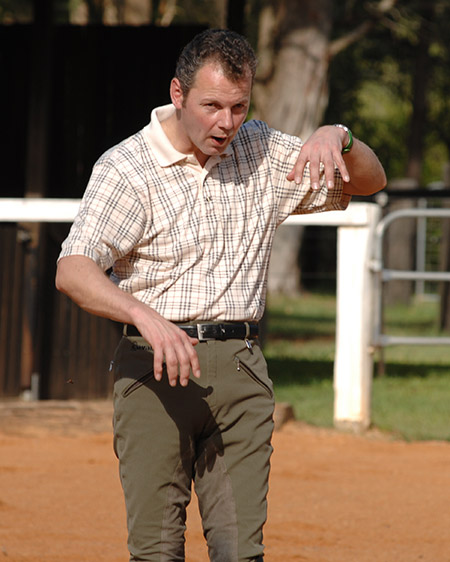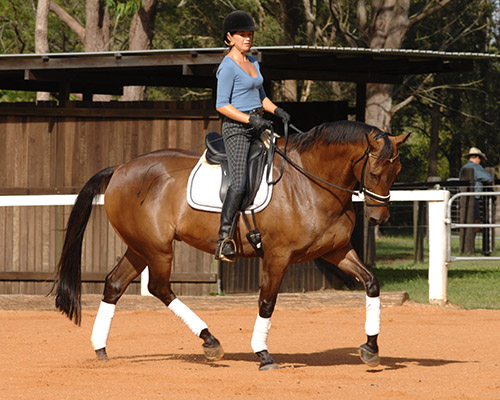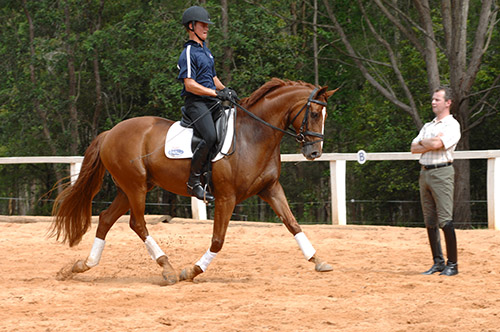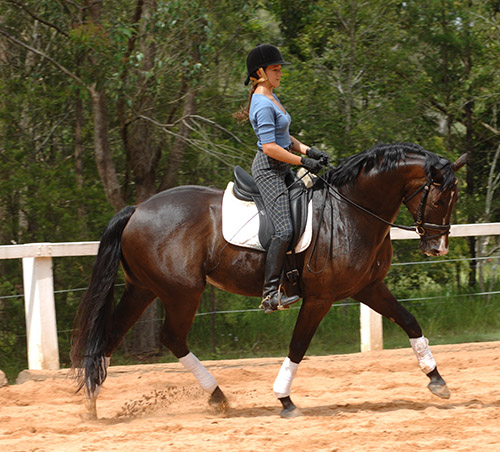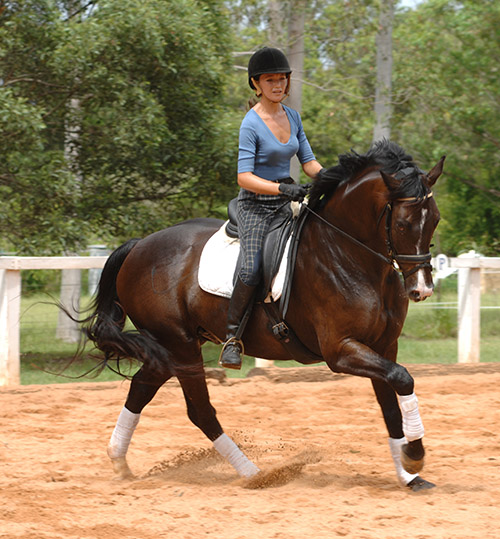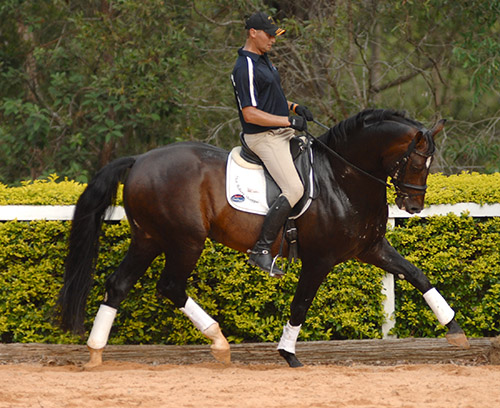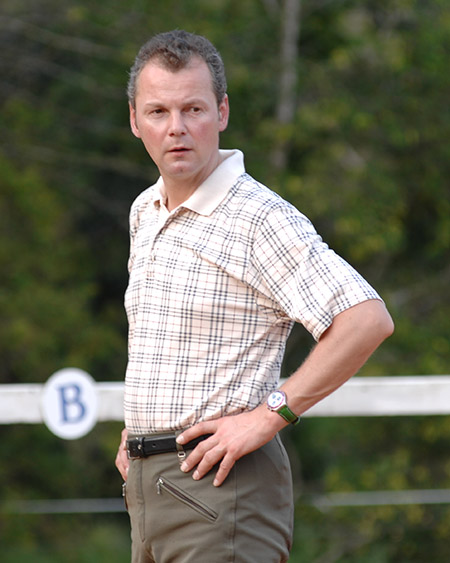Shannan Makauskas saddles up for a lesson with a visiting German instructor
Story by Shannan Makauskas Photos by Alex Makauskas
The Hanoverian Verband in Germany and the Hanoverian Society of Australia are responsible for importing and breeding many talented horses. But they soon realised correct training was needed to complete the picture and imported a different type of German – one with two rather than four legs.
Joern Kubelke began riding at eight years of age doing everything from vaulting to jumping. When Joern was given the opportunity to complete his Bereiter accreditation with the current German National Coach, Holger Schmezer, he decided to focus on Dressage:
“It was a good chance to have a play at Holger’s and I like to play with the horses. I like to work with the young horses to bring them up. It’s fun when you feel the horse progressing up the levels and when you have nice horses with potential it’s really interesting.”
For a year and a half Joern managed the private stables of Arthur Kottas-Heldenberg, who was the first Obereiter of the Spanish Riding School in Vienna.
Joern then began working for the Hanoverian Verband:
“I started as a rider and a trainer. Now I help clients buy horses. That’s also why I came here because while I was working for the auction house in Verden the society in Australia said, ‘That’s an interesting combination. He knows how to work with the young horses and he is also competing Grand Prix level.’”
Over the years Joern has ridden many of the ‘elite lots’ in the annual Verden auction, including Cinderella, who was ridden to much success by Matthew Dowsley. Cinderella was the highest placed Australian based Australian team horse at the World Equestrian Games in 2006.
Joern remembers the mare who earned a reputation for her fiery nature: “She had good ground quality. She was sometimes a little bit in her own mind but there was huge potential there.”
While working at the auction Joern was given the ride on another chestnut mare, Wansuela Suerte, who went on to be part of the German Gold Medal Team at the 2004 Olympics with Hubertus Schmidt.
Joern has helped many Aussies buy talented horses from Germany such as the latest addition to Remi Stud, Lauries As (Londonderry/Pik Bube I), and the winner of last year’s six year old class at the National Dressage Championships, Brentanus (Brentano II/Weltmeyer), ridden by Victoria Welch.
Joern runs his own private stables in Bremen, Germany and is a fully qualified Pherdewirtschaftsmeister. Several notable Aussie riders have gone there to train including the breakout star of the Grand Prix CDI circuit, Emma Flavelle, and Gold medallist at the Sydney Youth Olympics, Victoria Welch.
The organiser of the Australian clinics, Dean Izzard, has enjoyed a long standing relationship with Joern and has travelled annually to train at his barn for the last four years:
“Generally I go for a two or three week period but it’s taken a few years for it to get to the point where it’s at now. In the beginning it was helping, cleaning bridles, tacking horses, riding horses. Some horses were nice to ride and some horses weren’t and you just suck it up and do it.”
“But now it’s to the point where it’s fairly civilised in that I get up and I’m in the barn by about eight, will ride ’til twelve or one and then the afternoons are free time. I get on well with Joern’s wife so we’ll go shopping or go out for lunch. Last year was particularly good with the Bundeschampionate while I was there.”
Joern acknowledges how difficult training overseas can be for riders: “I mean the Australian must learn in Germany that it’s another system with the horses’ work. It starts in the morning feeding the horses and getting everything ready. Then after breakfast we ride the horses and most of the time it’s one after another and that’s sometimes hard for the people who don’t know it.”
There are between 15 and 20 horses at Joern’s barn where he rides 10 to 12 a day and has two girls to help with the stable work. His wife, Ulrike, completes the team by keeping the office side of things in order.
I asked Joern about his previous Grand Prix mount, Charmeur, who he rode at the elite auction in 1997 as a young horse. Two years later the owner went ill and left the horse with Joern to train: “Then there came a day when she said maybe the horse is too good for me and I should sell him so we made a quick decision and we bought him.”
Charmeur eventually introduced Joern to the Grand Prix competition circuit: “Then you’re at different shows and you meet different people. I think it was important for me because people would see me place up to Grand Prix level with a horse I brought up levels. So it’s good for my reputation and for my work.”
“We got to the stage where he was good but he was not going to be a world champion so I wanted to concentrate on the younger ones. We still own him but he’s now retired from Grand Prix level.”
Charmeur’s last show with Joern was at the PSI Horses and Dreams show last April where they scored 61.49 to place 23rd in the Grand Prix.
“He’s 16 years old and now he is being ridden by an 11 year old girl who will start with some smaller ‘L’ level shows. He’s a good schoolmaster for her, she can learn a lot with him and I still ride him between her visits.”
Thanks to Australian owner, Elaine Harrison, Joern has another talented young horse to keep him in the FEI ranks. The ten year old, Simba G (Falkland Victory/Northern Congress), was brought over from Australia in April 2009.
The stallion was formerly named Northern Simba and under the guidance of Matthew Dowsley was named the NSW Small Tour Champion in 2007. Since coming to Joern he’s placed consistently in small tour classes as well as ranking 3rd and 4th in his first Inter II competitions:
“This year I want to ride in the Median Cup which is an Inter II and Grand Prix competition for horses eight to ten years old. The older ones are not allowed so it’s a little bit easier for the younger ones. The Grand Prix is all there but there are still a lot of small things that must be better.”
Upon returning home Joern competed in the Median Cup Inter II warm-up round in April at the Horses and Dreams CDI in Hagen, Germany, placing 37th with a 60.631%.
Joern’s second hope is another Australian horse, Welton Fyne FF, owned by Flora Freeman. Also campaigned in Australia by Matthew Dowsley, the mare won the Australian Novice Championships in 2008.
Now rising ten, Joern hopes to compete Welton Fyne FF in the small tour ranks: “I’m happy to have them and have the owners trust me. Because I’m on the other side of the world so it means a lot that they trust me to have them at my stables and everything.”
“That’s very important in our business because there are a lot of professionals who are not the same way as I am and also there are some owners who aren’t so easy but it works.”
Joern’s first visit to Australia was in 2004 and with the exception of the year of the Equine Influenza lockdown in 2007/2008, he has conducted two clinics a year.
So have you noticed an improvement in the riders since then?
“With some riders there is good improvement. With some riders there is not so much improvement. But that may also be a little bit more professional riders who are thinking more about the training and how it could be better. Where as the hobby riders when you are not there and nobody’s looking then they are riding only half.”
“You cannot make somebody in two or three days. You cannot take them from normal standard to a world champion in three lessons. It’s just some ideas for the homework then something must go on at home.”
“Most of the time in the beginning the basics are not really there. The biggest problem is most of the people don’t know how to work a horse making the basics and using gymnastics to get them through their body.”
Joern enjoys the coaching side as well as competing: “When it works really well its fun. Also when it gets better and better and you have some good riders who have some success you get to bring them up the levels.”
Over four days, I was lucky enough to be one of the 15 riders that benefited from Joern’s teaching methods at Dean Izzard’s ‘Equest Dressage’ centre in Elimbah, Queensland.
Dean describes Joern’s training system: “His teaching is based on the Classical Dressage methods. He inspires riders with his encouraging manner to achieve the utmost impulsion, suppleness and expression from every combination.”
Warm-up
Joern explains how he starts each training session: “It doesn’t matter whether the warm-up is for a three year old or a Grand Prix horse, the goals are the same. For me it’s really important that they are round and everything must come from behind, over the back and over the neck.”
Shannan and Goodtimes Solomon
This was the focus from the minute I stepped onto the arena riding the seven year old gelding Goodtimes Solomon (Goodtimes / Lander): “More walk, the rhythm must be there even in the beginning. Come, come, come. If he is active behind in the walk then it will be there in the trot.”
Joern wants me to have Solomon’s reactions a little sharper to my leg: “They must understand when you come a little bit with your leg then they must come through, not trot and run away.”
“Ride leg yield over the diagonal just in walk. More haunches and more bend, more activity. Come, come, come. That’s better.”
Joern points out common mistakes made in the warm-up: “I must say, not only here but in other lands also, they hold them round or hold them so they don’t swing. Most of the time they are thinking quicker and forwards but they are only running and they have no rhythm.”
Bearing this in mind we picked up rising trot on a 20 meter circle: “Think about your trot rhythm from the beginning. Come forward then whoa, now ask something, little bit collect. Good and forward.”
“Now some medium and collects on the long side. Good, now collect, quicker behind, now medium. Now we see he starts to come quicker, now you feel he comes up.”
We then begin the canter work: “Wake him up with both legs, he must react. Now collect, think the haunches are riding medium. Now forward again, now collect again.”
“We want him quicker behind. Bring him on a small circle and hold him on the haunches, ask for something. Good, now forward and back on the bigger circle.”
“They must be round enough, have activity from behind, the engine must be there and then there are a lot of transitions. Then automatically they are more on the haunches. When everything works okay then we try the exercises and it’s no problem.”
This theory determined the pattern of every lesson – ride on a 20 meter circle making transitions within the pace, when the horse is swinging and engaged move onto a lateral exercise. If there’s a mistake in the lateral go back onto the circle and get them taking more weight on the haunches before a second attempt.
This meant there were rarely confrontations between horse and rider with the idea being to improve the pace and the movement will come good from that. This had a better effect than struggling in a shoulder-in, trying to push for more rhythm which wasn’t there to begin with.
Transitions
Riding the seven year old gelding, Leandro (Lauries Crusader), in his third clinic with Joern, 18 year old Elliot Patterson demonstrates the preparation Joern requires before starting a lateral movement: “Go forward and back on the circle but catch the hind legs, don’t let him rush. It’s getting too fast, whoa. That’s better.”
Leandro and Elliot…
“Trot in your rhythm, not more, good. Ride only from your seat and your leg. Think of coming one millimeter with the outside rein to make him straight. Don’t rush then he loses the swing, think about the rhythm and keep him in it with your seat.”
Elliott makes several transitions within the trot. Joern says: “Nearly walk, then go forward again, then he starts to swing. With your inside leg think you want to ride with the haunches one millimeter out into the outside rein. Good, that’s looking better.”
Leandro is now working in an uphill frame and swinging through his whole body, so it’s time to ride a half pass: “Ride a small circle then come into the half pass. More haunches, don’t lose the rhythm. Not too much flexion.”
Joern wants Leandro crossing over more so they ride some leg yields in trot but not without some changes within the pace: “Think of the haunches, now collect a little bit. When they lose the rhythm ask something from the hind leg, good. This is better yes?”
“Ride with the haunches in front, now hold him there and collect. Now on the circle a little bit forward and back. Come with both legs don’t collect them only with the hands it must come from behind and through. Forward, collect, hold him under you.”
“Outside rein, not too much flexion, then a half pass. Think you want to ride haunches leading, good that’s better. Now forward and back on the circle again. Hold the rhythm under your seat, talk to him.”
Staying on a smaller circle Elliot is asked to ride haunches-in before starting another half pass: “Outside rein, come from your leg. That looks better can you feel it?”
At last its time for a walk break and then the work resumes: “When you take up the reins ask something from behind. Now he looks like he wants to lean a little on the bit so we need to collect and take him forward. He must take the weight. Not forward, collect him again. Good, can you feel that now?”
They begin to prepare the canter for more work on the half pass: “Canter inside leg to outside rein. Not forward we just want a little more activity from the haunches. He’s running away so do some half halts. Now ask a little more from the haunches, come with both legs and wake him up a bit. Only use the whip if they ignore the leg.”
Joern describes the motions he goes through when beginning the half pass: “When I want to ride a half pass I make a half halt and come with the haunches first. You must think about it. Little collect, think canter on the spot. Collect, shoulder-in, haunches, half pass.”
They ride a seamless, flowing half pass across the diagonal and it’s back to the trot to finish: “Now transition to trot and straight away collect on the haunches, think about riding some half steps but keep him round.”
“Inside leg to outside rein, make him straight. Now come, come, come. Trot on the haunches not so he wants to lean on the forehand. Now walk. When you make a transition to walk, think to almost go into piaffe before it.”
Elliot confirmed that the work hasn’t changed much from his first lessons with Joern: “It’s still going forward and back, getting the activity from behind. I think with my riding getting a bit more advanced, starting Prix St George and having a better horse I’m able to cope with the work now. It’s definitely upped the anti a bit but the fundamentals still haven’t changed.”
The lesson reminded Elliot to keep checking the basics before working on the movements: “My straightness was the main thing. Then I’ve probably been letting him go a bit too forward and need to sit him back and just get him more from behind.”
“But it was definitely the straightness that I thought was the one thing that needed more improvement because that fixes a lot of things in your lateral work. If you get straightness on the circle then the half pass comes more easily and brings the quarters.”
Flying Changes
Riding my other seven year old gelding, Rotsdom (Rotspon / Dutchman), Joern wanted to work on the flying changes. The changes had only recently been introduced so needless to say we put on a good display of bucking for the spectators!
We start by riding several transitions within the canter on a 20 meter circle: “Into canter, wake him up. Think quicker behind. Bring him onto a smaller circle and collect, we need to get the hindlegs quicker to make the change.”
On a 10 metre circle, making a figure of eight, we ride a change each time we cross the centreline. The idea was to keep him collected before and after the change by staying on a small circle, making it difficult for him to run away.
“Hold him on the haunches. Outside rein and outside leg hold him under you, now collect and ask for the change. Good now collect again. After the flying change he must stay collected. Straight away we must ask him to collect on the haunches.”
We tried a few times and while the right to left change was clean every change, the left to right produced a kick. Joern identified the problem: “He is slower on the right hind yes? So we must make him more active to get the change, tuk tuk with the whip in the half halt. Think you are going to ride a pirouette. Now ask for the change, good that one was clean.”
Laterals
Although Joern assured me the warm-up is the same for every horse, as I watch Tor Van Den Berge riding Fishermans Friend (Fabriano / Pik Bube I), I can’t help but think a Grand Prix horse certainly makes it look better.
Tor and Fisherman’s Friend…
They start in walk on a 20 metre circle then it’s into rising trot with some transitions: “Think about the neck, inside leg, come under and round. It’s only a small transition no one else can see it, it’s just for you. Round and deep and over the back. Again a little bit forward, trot quick, think about your hands.”
“The neck is much better now yes? But a little more flexion. Out and longer with the neck. Do a little bit of leg yield on the circle, you should only need a little calf to get a reaction.”
Tor demonstrates exactly what Joern wants when riding ‘forward backs’ with Fishermans Friend moving seamlessly from a quick tempo passage to a swinging collected trot. The back is loose and the gullet is opening into a nice frame.
“Into canter, come come come. Make it quicker but loose in front. Little forward, collect, little forward, collect. Now think canter on the spot, rounder, deeper. Now into sitting trot. Now he looks like he wants to go.”
“Ride a little bit haunches-in on the circle so when we want to do the half pass he’s supple from behind. Now quick but light, not so high in the poll. Take him a little bit forward but only for one or two metres then a transition. That looks good.”
Joern said of riding half pass in the test: “One of the problems is they’re coming from the corner so you need to remember to have the travers.”
Tor said: “He knows when they’re coming up so he gets there and runs away and then I’ve got nothing.”
So Joern instructs Tor to ride with the haunches slightly in on the circle and then to go back on the long side: “Collect and pick it up a little from behind. Ride a little passage and haunches in on the corner and then ride the half pass.”
“Collect, little bit haunches in before the half pass. Now he starts to move again, quicker behind. Now passage, now only to think a little bit haunches in then riding half pass for one or two meters, then straight and get him back into the rhythm you want then half pass again.”
“Now shoulder-in, half pass, shoulder-in and half pass. Now on the diagonal ride only travers from A to B, think you only want to ride travers, come quicker, more forward, come, come, that’s better.”
“Ride some trot walk transitions on the circle. Trot in your rhythm, now forward, quick. Come, come, come and half pass, then straight. Nearly passage, now forward, now back. Think rounder frame from the base of the neck. Now he is loose.”
Tor tells me about his past experiences with Joern: “He’s really been the secret to this horse. I’d had lessons on Alabaster with Joern but Fish had been with me for six weeks when Joern was out here. He came along when I was probably a little lost and he just put us on the right way.”
“It’s really basic, it’s just speed the hind leg up. It’s simple and it’s easy for me to put to practice. Fish’s come back really well after a little time off breeding and he’s come back a better horse and I think this years going to be fun, really good fun.”
So what homework did Tor take from today’s lesson? “Half halts. Just half halts. Being able to speed him up behind and being able to make the half halt in the half pass, being able to adjust the trot. I think that’s really the important thing and for Grand Prix especially.”
“In the Prix St George I was able to get through with just a little leg and really make the test look good but in Grand Prix they have to do it all for you. So I’m very much working on making him easier to ride and the hind leg today has gotten a lot quicker. Joern spoke to me afterwards and he was happy with the progress.”
“I now need experience and the horse needs experience at every comp. The horse is a really good competitor and I enjoy competing so we’ll do Dressage with the Stars for our first one and then we’ll just progress from there.”
Unfortunately at the PSI Dressage and Jumping with the Stars competition in March they had all the stallions stabled next to each other and Fishermans Friend put his legs over the stable wall, injuring his tendon.
Tor said: “I took him to the vets straight away and on scan my worst fears were realised when it showed a small hole. We have since then treated the tendon and have done everything possible to help the tendon heal to the best it can.”
“We don’t know exactly how long he will be out for. We’ll let him be the judge of that but we’re all hoping he’ll be back in full force for Nationals. We were all very disappointed as he was really starting to get stronger with the work and he was really starting to know his job.”
Once a full recovery has been made Tor will: “Take him at his speed and make sure the tendon is completely healed and then get on with the job of Grand Prix. I’d really like to thank Cheryl (O’Brien, owner) for being so wonderful through the whole thing and to everyone that has been so supportive in Melbourne and at home.”
Dean Izzard summarised the benefits of the clinic: “I like that Joern doesn’t change his training methods. They are the same now as they were the first time he came.”
“It’s just the consistency of sticking with one trainer and following a principle that’s based on the German training scale. There are some people like Tor who have been coming for all these years and it’s good to see people progressing with their training.”




